Introduction » Review of Frontal Types and Identification Conventions
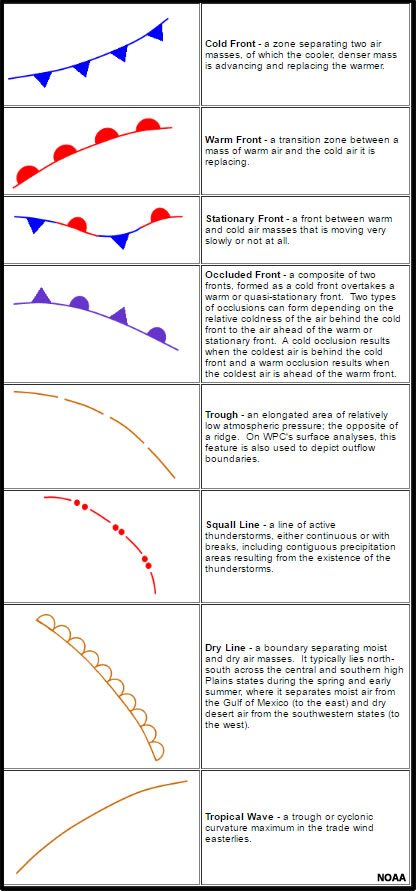
In a standard surface analysis you may find 4 main types of synoptic scale fronts, plus a front tied to local topography and land type, as well as other symbols to indicate common meso/local scale features of interest and pressure-related features.
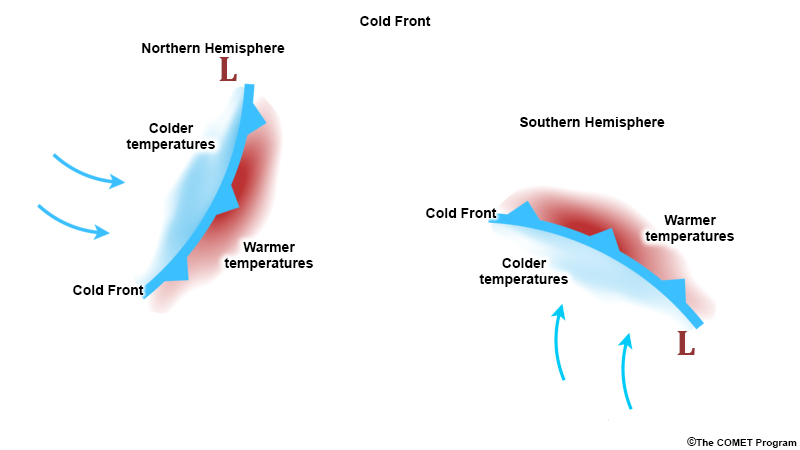
Cold fronts are typically analyzed at the leading edge of a density discontinuity ahead of a cooler/colder airmass. Cold frontal zones tend to be narrower than warm fronts because the trailing airmass is normally of higher density and thus helps drive forward motion. They are analyzed as a blue line with solid blue triangles pointing toward the warmer airmass. Typically air behind the front will possess lower temperatures, lower dewpoint temperatures and winds will have westerly component (in midlatitudes)
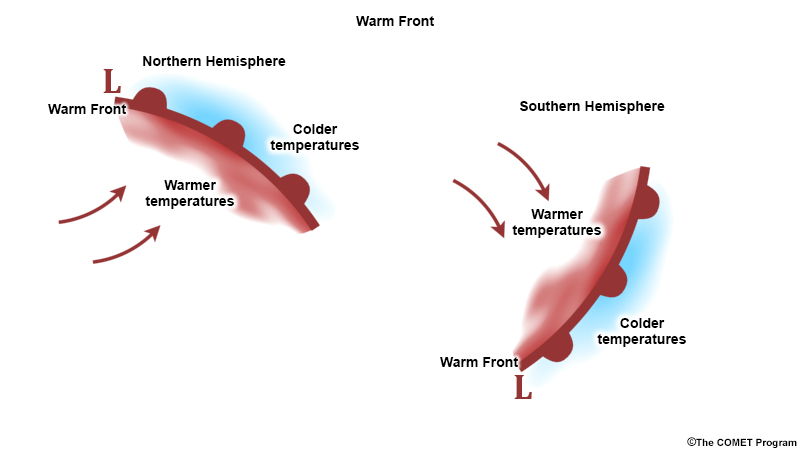
Warm fronts are typically analyzed at the equatorward edge of a density discontinuity behind a retreating and modified cooler airmass. Warm frontal zones tend to be broader than cold frontal zones because the denser airmass ahead of the front erodes slowly. Warm fronts are analyzed as a red line with solid red semicircles that face into the warmer airmass. Typically air behind the front will possess warmer temperatures, higher dewpoint temperatures and winds will have southerly component (in midlatitudes).
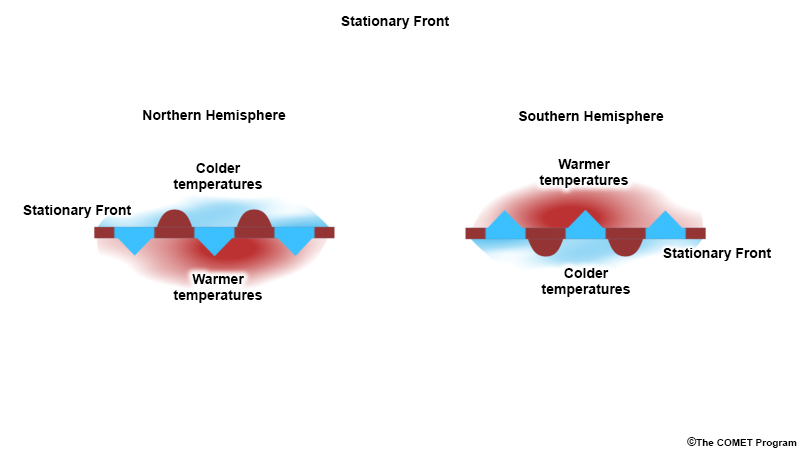
Stationary fronts are typically analyzed at the equatorward edge of a stationary or very slow moving density discontinuity. Stationary frontal zones tend to be narrower than warm frontal zones, but broader than that for most cold fronts, because the boundary is not moving but may have flow that is parallel to slightly frontogenetic. A common synoptic setup for stationary front development includes mature to decaying cold fronts that stall after the main cyclone has passed, sometimes in conjunction with weak to moderate flow into the area from an anticyclone.
Topography also causes many stationary fronts to be analyzed at particular locations, such as when a cold front pushes southwestward into the Rocky Mountains in Colorado, Wyoming and New Mexico, or similarly when cold air becomes “dammed” at low levels in the Appalachian mountains.
Stationary fronts are analyzed as alternating red semicircles and blue triangles as seen above. Typically, air on the cooler side of the stationary front will have lower dewpoint temperatures and flow roughly parallel to the front, while air on the warmer side will have higher dewpoints, a southerly component and flow either parallel to the frontal zone, or toward it. Occasionally, extended areas of directly opposing flow will intensify and strengthen a stationary front.
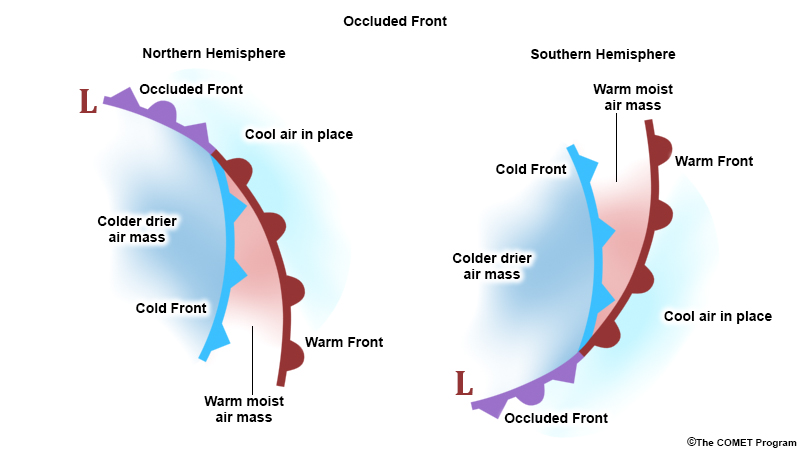
Occluded fronts are typically analyzed in the late stages of cyclone development when the coldest air associated with a cyclone is still well behind the cold front but the leading edge of cold air has advanced enough to displace the cooler air poleward of the warm, moist airmass (cold occlusion). Situations in which the coldest air associated with a cyclone is instead found poleward of the warm, moist airmass results in pushing the cold front aloft (warm occlusion).
Occluded fronts are analyzed using purple line with alternating solid purple semicircles and triangles. Typically air behind the occluded front will possess colder temperatures, lower dewpoint temperatures and winds will have westerly component while air directly ahead of the occluded front will be cool, have slightly higher dewpoints, and come from an easterly and/or southeasterly direction - the warmest, moistest airmass will be cutoff and to the south of the low pressure center, with generally southerly winds.
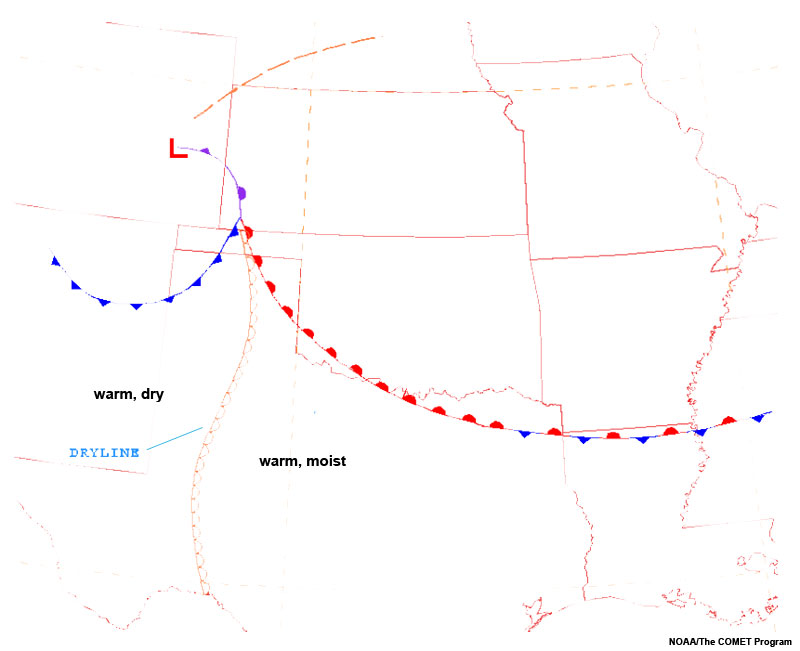
Drylines are typically analyzed at the leading edge of a strong density (moisture) discontinuity forced by downslope winds off the Rockies into the southern plains, often in conjunction with lee cyclogenesis. Drylines usually advance eastward during peak diurnal heating and retreat westward in the overnight hours. Drylines typically possess a strong dewpoint gradient that can approach a 30°F difference over 200km, and sometimes can approach 50°F differences in narrow zones. Drylines are often the focus of intense convection during the springtime months. Drylines are analyzed as a brown line with scallops facing toward the moist airmass.